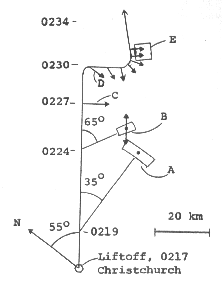Bruce S. Maccabee : Applied Optics, Vol. 19, No. 11, pp. 1745-46,
: Applied Optics, Vol. 19, No. 11, pp. 1745-46,
 : Applied Optics, Vol. 19, No. 11, pp. 1745-46,
: Applied Optics, Vol. 19, No. 11, pp. 1745-46, Maccabee [1] a d�clar� que des sources conventionnelles �taient exclues comme explications possibles pour les observations et le film d'une source lumineuse tr�s intense (105-106-cd) depuis un avion qui volait vers l'est de l'Ile Sud de Nouvelle Z�lande le 31 entre 2 h 19 et 2 h 33, heure locale. Ireland et Andrews [2] ont sugg�r� que la lumi�re venait en fait qu'un bateau de p�che squid that would have been fishing ~60 km north-northeast of Christchurch. In support of this explanation they have pointed out that a large squid fleet was in New Zealand waters at the time and that one of these boats "could have passed the site in question." Their information on the known locations of squid boats (several hundred kilometers east of and several kilometers north and west of the South Island) came from the New Zealand Ministry of Agriculture and Fisheries; these boats also showed up on satellite imagery [3]. Squid boats maintain fixed locations while fishing. According to a more recent paper by Ireland [4], these locations are reported to the Ministry of Agriculture and Fisheries. However, ministry records failed to show any boats in the vicinity of the sighting area [4]. Furthermore, according to freighter aircraft pilots who have flown over the area in question for many years, squid boats have not been seen fishing in the Pegasus Bay, which is the body of water northeast of Christchurch where the hypothetical boat would have been. Since there is a lack of independent evidence for the existence of a squid boat at the location in question, the proof - or disproof - of the squid boat hypothesis must be based on information collected by the witnesses during the sighting.

When the plane was ~70 km from Christchurch, the pilot turned to the right. According to the witnesses (other than the pilot, who could not see the light from his left-hand seat because the depression angle of the line of sight was too great), the line of sight immediately after the turn was within 20 degrees of straight ahead. Ireland and Andrews claim that the turn angle was ~120 degrees to the right, which would be reasonably consistent with what would be expected if the plane turned toward a stationary light (e.g., squid boat). However, this amount of turning is contradicted by the explicit statement of the captain [3] that he turned from 033 magnetic to 125 magnetic [5] or 92 degrees. The more correct path of the aircraft is illustrated in Fig. 1. The figure illustrates two other modifcations [6] in the information of Refs. 1, 2, and 3: (a) the radar detections began within 20 sec of the initial visual sighting, rather than 3 min later as previously reported, and (b) the target went off the aircraft radarscope at ~60 degrees to the right rather than 50 degrees (the 63 degree angle on Fig. 1 is drawn to the center of the radar blip, estimated to be 6 degrees wide) [7]. Figure 1 also illustrates the estimated visual sighting directions after the target went off radar. These directions are estimated from witness statements made during the fiight (tape recordings and handwritten notes) and during extensive interviews after the flight.
Contrary to the stationary squid boat hypothesis, the available data suggest that the light moved a considerable distance during the 13 min or so that it was seen. According to the captain, the radar target moved in toward the center of the radarscope from 33-37 km to 15-22 km at approximately constant azimuth for several minutes, and then the target moved around to the right, disappearing at the limit of the sweep. As nearly as could be determined by the witnesses, the azimuth of the radar target was always the same as that of the light. As the flight continued, the witnesses had the impression that the object paced the aircraft at an apparently constant distance. Immediately after the turn the plane seemed to approach the light, but then it appeared to recede from or avoid the plane and move away and around to the right. There was a very noticeable depression angle in the line of sight after the turn, and there was no radar target, suggesting that the object was below the radar beam [1]. During the subsequent left turn the captain could not see the light directly because it was too far to the right and below his field of view, but he could see the glow in the right-hand windows. He was surprised to see the glow increase in intensity rather than decrease, as he expected would happen if he moved away from the light. A witness also recorded a statement mentioning an apparent increase in brightness during the turn. The light was last seen at the right at a depression angle of ~45 degrees as it appeared to move behind and below the plane. Since the plane was at an altitude of ~3960 m, the light came within ~6000 m of the aircraft.
Because Ireland [4] failed to find a squid boat in the vicinity of the sighting area and because the available evidence indicates that the light source was capable of rather rapid motion (e.g., at least 42 m/sec, 82 knots), it appears that the light did not come from a squid boat. More detailed information on this and other sightings that occurred the same night is available from this author [8].
R�f�rences :